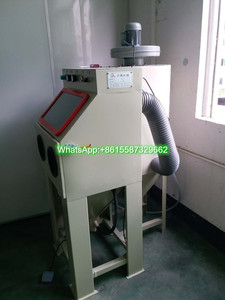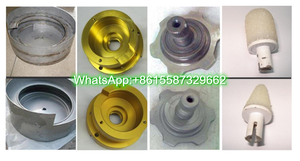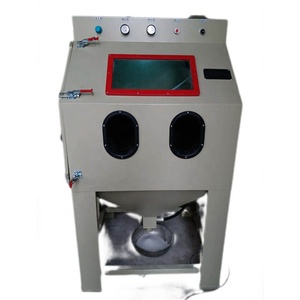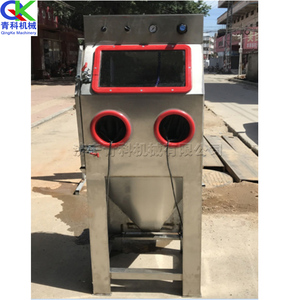
All categories
Featured selections
Trade Assurance
Buyer Central
Help Center
Get the app
Become a supplier

(1935 products available)




























The realm of industrial machinery encompasses a diverse array of equipment designed for various applications, and one such essential component is the sand blaster machines dustless . These devices are integral in the field of metal and metallurgy, providing efficient cleaning and surface preparation solutions. The sand blaster machines dustless operates by propelling abrasive materials at high velocity to remove rust, paint, and other contaminants from surfaces, ensuring optimal conditions for subsequent processes like painting or coating. Their versatility and effectiveness make them indispensable in industries ranging from automotive to construction, and understanding their capabilities is crucial for maximizing their benefits.
Different types of sand blaster machines dustless are available to cater to specific requirements and applications. The most common types include gravity-fed, pressure-fed, and siphon-fed sandblasters. Gravity-fed models utilize the force of gravity to feed the abrasive media into the nozzle, making them suitable for smaller tasks and delicate surfaces. Pressure-fed sandblasters, on the other hand, use compressed air to force the abrasive through the nozzle, allowing for more aggressive cleaning and faster processing speeds, ideal for large-scale projects. Siphon-fed sandblasters use a suction mechanism to draw the abrasive media into the air stream, offering a balance between power and control. Each type of sand blaster machines dustless is designed to meet specific operational needs, ensuring efficient and precise surface treatment.
The primary function of sand blaster machines dustless is to clean and prepare surfaces by removing unwanted materials, enhancing adhesion for coatings or paints. Key features of these machines include adjustable pressure settings, diverse nozzle sizes, and compatibility with various abrasive media. Adjustable pressure settings allow operators to tailor the intensity of the blasting process according to the material and desired outcome, ensuring precision and minimizing damage to sensitive surfaces. Different nozzle sizes enable versatility in reach and coverage, accommodating intricate designs and large areas alike. Moreover, compatibility with a range of abrasive materials, such as glass beads, aluminum oxide, and steel grit, enhances the adaptability of sand blaster machines dustless to various industrial requirements.
In the operation of sand blaster machines dustless , the choice of abrasive media is crucial, as it directly influences the effectiveness and quality of the surface treatment. Common materials used include silica sand, glass beads, aluminum oxide, and steel grit. Silica sand is traditionally popular due to its availability and cost-effectiveness, although health concerns have led to the development of alternatives. Glass beads are favored for their ability to produce a smooth finish, making them suitable for delicate surfaces. Aluminum oxide offers aggressive cleaning capabilities, ideal for removing stubborn contaminants. Steel grit provides durability and efficiency, making it perfect for heavy-duty applications. Selecting the appropriate media ensures that the sand blaster machines dustless performs optimally, delivering the desired surface characteristics.
Effective use of sand blaster machines dustless requires understanding the equipment and optimizing its settings for specific tasks. Operators should begin by selecting the appropriate type of sandblaster and abrasive media based on the material and desired finish. Adjusting the pressure settings is essential to balance efficiency and surface protection, while choosing the right nozzle size ensures adequate coverage and precision. Proper safety measures, including wearing protective gear and ensuring adequate ventilation, are imperative to safeguard against hazards associated with the blasting process. Regular maintenance, such as cleaning the machine and replacing worn components, ensures longevity and consistent performance of the sand blaster machines dustless . By adhering to these guidelines, operators can achieve optimal results and enhance the productivity and effectiveness of their surface preparation processes.
When selecting the most suitable sand blaster machines dustless for your needs, it is essential to consider the specific applications and materials involved. One of the primary factors to evaluate is the type of abrasive media you plan to use, as different media are compatible with different machines. Additionally, the power source and pressure capacity of the sand blaster machines dustless can significantly impact its efficiency and suitability for various tasks. For instance, a higher pressure capacity is advantageous for removing tough contaminants, while a lower pressure setting may be preferable for delicate surfaces. Evaluating these aspects will help ensure that the sand blaster machines dustless chosen meets the demands of your industrial processes.
Another crucial consideration when choosing a sand blaster machines dustless is the size and design of the nozzle. The nozzle's dimensions influence the coverage area and the precision of the blasting process, which can be critical depending on the surface being treated. For intricate designs or components with tight corners, a smaller nozzle may be more appropriate, while larger surfaces might benefit from a wider reach. Furthermore, the material of the nozzle, typically made from tungsten carbide or ceramic, can affect its durability and lifespan, particularly when used with abrasive media like aluminum oxide or steel grit. Selecting the right nozzle ensures optimal performance and longevity of the sand blaster machines dustless .
Safety features and ergonomic design are also important factors to consider when purchasing a sand blaster machines dustless . Look for machines equipped with safety mechanisms such as automatic shut-off systems and pressure relief valves to protect operators during use. Additionally, user-friendly controls and adjustable settings can enhance the ease of operation, reducing fatigue and improving productivity. Considering the working environment, it is also advisable to choose a sand blaster machines dustless with noise-reduction features, especially in settings where prolonged exposure to high noise levels could be detrimental to health.
Regular maintenance of a sand blaster machines dustless is crucial to ensure its longevity and performance. This includes routinely checking and replacing worn nozzles, cleaning filters, and inspecting hoses for leaks or damage. Proper storage of the machine and its components, especially in a dry environment, can prevent corrosion and other issues arising from moisture exposure. Additionally, ensuring that the abrasive media is free of contaminants can help maintain the efficiency and effectiveness of the sand blaster machines dustless .
The primary distinction of a sand blaster machines dustless from other surface preparation tools is its ability to propel abrasive materials at high speed to clean or etch surfaces. This method allows for rapid removal of rust, paint, and other contaminants, offering a more thorough surface treatment compared to manual tools or chemical methods. The versatility in media choice also allows a sand blaster machines dustless to be adapted for various applications, providing a unique advantage over other equipment.
While a sand blaster machines dustless can be used on a wide range of materials, it is essential to select the appropriate media and settings for each specific material to avoid damage. Metals, concrete, and wood are commonly treated with sandblasting, but more delicate materials like glass or softer metals require careful handling and the use of less aggressive media such as glass beads. Understanding the material's properties is crucial in determining the suitability of a sand blaster machines dustless for the task.
Using a sand blaster machines dustless requires adherence to strict safety protocols to protect operators from potential hazards. This includes wearing appropriate personal protective equipment such as gloves, goggles, and respiratory masks to shield against dust and debris. Ensuring adequate ventilation in the work area is also vital to minimize inhalation risks. Additionally, operators should be trained on the proper use and maintenance of the sand blaster machines dustless to prevent accidents and ensure safe operation.
Choosing the right abrasive media for a sand blaster machines dustless involves considering the material of the surface being treated and the desired finish. For instance, steel grit is suitable for heavy-duty cleaning of steel surfaces, while glass beads are ideal for achieving a smooth finish on delicate materials. The media's hardness, shape, and size also play a role in determining its effectiveness for specific applications. Conducting tests or consulting with experts can help in selecting the most appropriate media for your sand blaster machines dustless